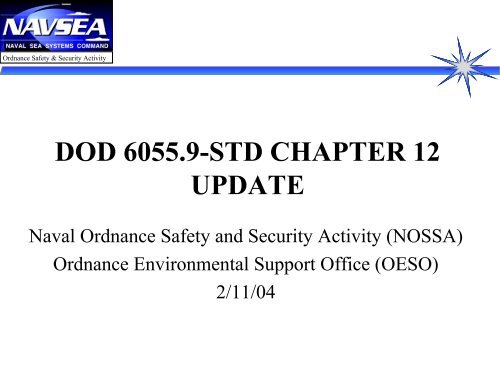DOD 6055.9-STD CHAPTER 12 UPDATE
DOD 6055.9-STD CHAPTER 12 UPDATE
DOD 6055.9-STD CHAPTER 12 UPDATE
Create successful ePaper yourself
Turn your PDF publications into a flip-book with our unique Google optimized e-Paper software.
Ordnance Safety & Security Activity<strong>DOD</strong> <strong>6055.9</strong>-<strong>STD</strong> <strong>CHAPTER</strong> <strong>12</strong><strong>UPDATE</strong>Naval Ordnance Safety and Security Activity (NOSSA)Ordnance Environmental Support Office (OESO)2/11/04
BackgroundOrdnance Safety & Security Activity• Focuses on explosives safety issuesassociated with real property (i.e. land)• Last updated July 1999• Increasing regulator/stakeholderinvolvement• Inadequate for current Service needs:– Confusion regarding approval requirements– Questionable applicability to remediation projects• Eight pages in length2
Current Chapter <strong>12</strong>Ordnance Safety & Security Activity• Main topics:– Scope– Policy– Procedures• Identification and Control (Active Installations)• Land Disposal (Active Installations)• Remediation of FUDS• Remediation Methods and Use Restrictions• Termination of Use of Facilities Storing Ammunition andExplosives– Mineral Exploration and Extraction3
Specific IssuesOrdnance Safety & Security Activity• Explosive Safety requirements for the:– Cleanup of property leaving DoD control– Remediation of property remaining under DoDcontrol• Associated explosives safety approvalsand/or endorsements4
Draft Chapter <strong>12</strong>Ordnance Safety & Security Activity• Scope• Identification & Control of AreasKnown/Suspected to Contain MEC• Munitions Responses• Special Considerations• Explosives Safety Submission (ESS) and SitePlans5
Draft Chapter <strong>12</strong> (Cont.)Ordnance Safety & Security Activity• Chemical Safety Submission (CSS) andChemical Interim Holding Facility (IHF)Site Plans• Amendments and Corrections• After Action Reports• Transfer of Property• Change of Use6
Chapter <strong>12</strong> AdditionsOrdnance Safety & Security Activity• Outlines new environmental munitionsresponse terms• Includes Chemical Munitions responses• Provides Munitions Response guidance• Addresses residential development• Outlines ESS/CSS requirements–Types– Exclusions– Minimum requirements– Approvals/Documentation7
Chapter <strong>12</strong> AdditionsOrdnance Safety & Security Activity• Provides UXO Technician qualification/trainingrequirements• Defines “Explosive Soil”• Requires AAR submission• Prohibits transfer of property known or suspectedto contain MEC– OSD approval required for any exceptions• Requires a munitions response at property knownor suspected to contain MEC prior to a change inuse8
ESS TypesOrdnance Safety & Security Activity• Site Investigation/Site Characterization• No Defense Action Indicated (NDAI) or NoFurther Action (NOFA)• Time Critical Removal Action (TCRA)• Construction Support involving MECRemoval in the Construction Footprint• Selected Removal or Remedial Response9
ESS ExclusionsOrdnance Safety & Security Activity• Explosives or munitions emergencyresponse• Activities on operational ranges• Munitions responses at sites involving onlysmall arms ammunition (No HE)• On-call construction support• Anomaly avoidance10
Chapter <strong>12</strong> DeletionsOrdnance Safety & Security Activity• To be moved to another chapter:– Termination of Use of Facilities StoringAmmunition and Explosives– Mineral Exploration and Extraction• To be deleted:– FUDS specific discussion– Assessment Depth table11
NOSSA ConcernsOrdnance Safety & Security Activity• Five ESS types• All ESSs submitted to DDESB for approval<strong>12</strong>
Future ActionsOrdnance Safety & Security Activity• Last Working Group meeting was held on<strong>12</strong> & 13 Nov 03• Next DDESB Meeting in March 04Questions????13
Ordnance Safety & Security ActivityBackup Slides14
New Chapter <strong>12</strong> TermsOrdnance Safety & Security Activity• Anomaly Avoidance. Techniques employed on property known orsuspected to contain MEC to avoid contact with potential surfaceor subsurface explosive hazards to allow entry to the area and theperformance of required operations.• Construction Support. On-call or on-site assistance provided byqualified EOD or UXO personnel during construction activities onproperty known or suspected to contain MEC, to include propertyknown to contain only residual MEC, to ensure the safety ofpersonnel or resources from any potential explosive hazards.15
New Chapter <strong>12</strong> Terms (Cont.)Ordnance Safety & Security Activity• Material that Presents a Potential Explosive Hazard (MPPEH).Material potentially containing explosives or munitions, orcontaminated with a high enough concentration of explosivessuch that the material presents an explosive hazard. Suchmaterial includes, but may not be limited to: munitionscomponents; munitions containers and packaging materiel;munitions debris (scrap metals, plastics, etc.) remaining aftermunitions use; equipment and munition debris related toresearch, development, testing and evaluation; range-relateddebris; targets; and residues resulting from production ordemilitarization. Excluded from MPPEH are other hazardousmaterials (e.g., gasoline, compressed gas, etc.) that are not amunition and are not intended for use as a munition.16
New Chapter <strong>12</strong> Terms (Cont.)Ordnance Safety & Security Activity• Munitions Response. Response actions, including investigation,removal and remedial actions to address the explosives safety,human health, or environmental risks presented by unexplodedordnance (UXO) or discarded military munitions (DMM), or bymunitions constituents (MC).• Munitions Response Area (MRA). Any area on a defense site that isknown to require a munitions response and that contains one or moremunitions response sites. Examples include former ranges andmunitions burial areas.• Munitions Response Site (MRS). A discrete location that, based oninvestigation or characterization, is known or suspected to containUXO, DMM, or MC.17
New Chapter <strong>12</strong> Terms (Cont.)Ordnance Safety & Security Activity• Time Critical Removal Action (TCRA). Removals, which concerna release that must be initiated within 6 months of discovery of thehazard, tend to involve less acute circumstances than anemergency, yet prompt action is warranted. Important factors arethe nature and extent of the release and its possible impact onnearby populations or a particularly sensitive environment.• Munitions and Explosives of Concern (MEC). This term, whichdistinguishes specific categories of military munitions that maypose unique explosives safety risks, means:(A) UnexplodedOrdnance (UXO), as defined in 10 U.S.C. 2710 (e) (9);(B) Discarded military munitions (DMM), as defined in 10 U.S.C.2710 (e) (2); or (C) Explosive munitions constituents (e.g., TNT,RDX) present in high enough concentrations to pose an explosivehazard.18
New Chapter <strong>12</strong> Terms (Cont.)Ordnance Safety & Security Activity• Discarded Military Munitions (DMM). Military munitions that havebeen abandoned without proper disposal or removed fromstorage in a military magazine or other storage area for thepurpose of disposal. The term does not include unexplodedordnance, military munitions that are being held for future use orplanned disposal, or military munitions that have been properlydisposed of consistent with applicable environmental laws andregulations. (10 U.S.C. 2710(e)(2))• Land Use Controls (LUCs). LUC include any type of physical,legal, or administrative mechanism that restricts the use of, orlimits access t, real property to prevent or reduce risks to humanhealth and the environment. Physical mechanisms encompass avariety of engineered remedies to contain or reducecontamination and/or physical barriers to limit access to property,such as fences or signs.19
















